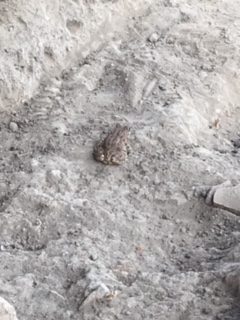No Toads Were Harmed in the Excavation of this Tel
by Samantha Foppe
No Toads Were Harmed in the Excavation of this Tel
No Toads Were Harmed in the Excavation of this TelTel Akko has its share of interesting critters. Some of the animals we’ve seen on this excavation season include: snakes, geckos, ants, bees, lizards, moles, and more. Some are dangerous, and some are much friendlier. In my square, we had a mole who dug several holes and even dug through into a stone wall. These animals, as well as others, contribute to our excavation and “help us dig.” The more scientific term for this help is bioturbation. Animals and plants disturb and change the soil in places they inhabit.
This week, my square had some new visitors: a family of toads. We had begun to remove a wall made of stones when we discovered them hiding inside. One had jumped out of its hiding spot under a large rock in the wall. At first, we thought it was a lone toad but then we realized there were four more tucked safely under the rock. For about ten minutes we tried to safely remove them so we could continue to excavate without harming them. Eventually, they all hopped out from under the rock and away from our square.
These toads had burrowed into the wall and made it their home. They may have changed the archaeology of the site, but we disturbed their home. Fortunately, it is really great that the toads left the area safely and it was interesting to see bioturbation in action.

